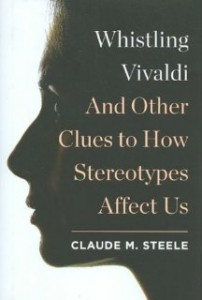 Many of us remember Jane Elliot’s groundbreaking Brown Eyed Blue Eyed Experiment first conducted in the 60’s where children were told one eye color was superior to the other and how consistently the children who were told they were superior based on eye color performed better on tests.
Many of us remember Jane Elliot’s groundbreaking Brown Eyed Blue Eyed Experiment first conducted in the 60’s where children were told one eye color was superior to the other and how consistently the children who were told they were superior based on eye color performed better on tests.
More recently, Stanford Professor Claude Steele, in his book Whistling Vivaldi: And Other Clues to How Stereotypes Affect Us, gives us numerous examples of how performance is impacted by what he calls stereotype threats. A stereotype threat is “a situational predicament felt in situations where one can be judged by, treated in terms of, or self-fulfill negative stereotypes about one’s group”. According to Steele what this means is that academic and intellectual performance is not simply contingent upon actual ability, but also the shared beliefs that people hold about the performance and abilities of different social groups. The book contains numerous examples of how stereotype threats impacted performance.
For example, black students performed worse on IQ tests when they believed that blacks are less intelligent and better when told that this was not true. Not confined to race, women perform better on math tests when they don’t think they will be compared to males, and older people perform better on memory tests if they don’t know they are being compared to younger people, where the stereotype is younger people have better memories.
Most often the individual is not consciously aware that they have internalized the stereotype and the impact that it has on their performance.
Steele and others have found that positive affirmations before taking a test or attending to a task can significantly increase performance. As an example, Researchers from Stanford University and the University of California, Santa Barbara worked with both Latino and white students over a three year period. They participated in “values affirmation” assignments throughout the school year. The students selected values that were important to them and how those values would be important to them in the near future. The Latino students who were a part of the affirmations group earned higher grades than their Latino peers who did not. The positive effects lasted for three years.
Even though there is strong evidence from Steele and others who have studied the impact of labels and stereotypes, we persist in using language to describe groups of people that can have the effect of increasing stereotype threats. Consider the following labels:
- Minorities
- At Risk
- Underperforming Schools
- Learning Disabled
- Limited English Proficiency
Children who are “branded” with these labels early in life carry them into adulthood and the impact can continue to subconsciously play out in the workplace. For example, the term “diversity hire” can carry all sorts of meanings to different people, including an assumption that the individual is not as qualified as someone without that label.
We should conduct more studies on the performance impact of stereotype threats in the workplace.
Photo courtesy of amazon.com


















